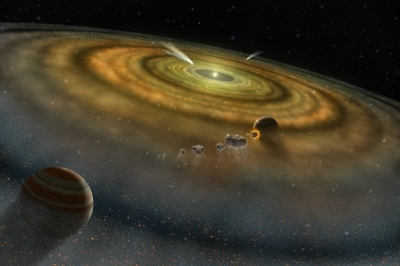
We know that the planets in our solar system orbit the Sun and rotate around their own axis in a counterclockwise (west to east) direction. But while all the planets orbit the Sun in this direction, not all of them rotate the same way around their own axis. Venus and Uranus rotate clockwise (east to west), also called retrograde rotation. During the formation of our solar system these two planets spun the same way as others, but there is no definite answer as to when and why they started spinning backwards. However, there are several theories.
The backward-spinning Venus
There are two main theories that try to explain Venus backward / retrograde rotation. The first theory suggests that at some point in time, post the formation of the solar system, Venus flipped its axis 180 degrees. This means, Venus continues to spin in the same direction as it always has, except it is now upside down. So, when looked at from other planets, Venus looks like it is spinning in the opposite direction.
Scientists believe Venus axis might have flipped due to the Sun’s strong gravitational pull on the planet’s dense atmosphere, which could have caused strong atmospheric tides. These tides, combined with the friction between Venus’ mantle and core might have caused the flip.
The second theory states that Venus might not have flipped at all. Scientists propose that the planet’s rotation slowed to a standstill and reversed direction. Scientists suggest this theory taking into account the factors mentioned in the first theory coupled with the tidal effects from other planets. They believe this might have caused Venus to eventually spin in a more stable retrograde state.
The side-spinning Uranus
Uranus, like Venus, rotates in the clockwise direction but its axis is tilted at 97.77 degrees, making the planet appear as though it is spinning sideways and orbiting the Sun like a rolling ball. The most popular theory suggested by scientists for Uranus tilt is the collision of the planet with an Earth size object. A more recent theory suggests that Uranus wasn’t hit once by a giant object, but collided multiple times with objects of a smaller size.
A collision-free theory suggests that during the initial days of planetary migration, Uranus had a large Moon whose gravitational pull caused the planet to fall on its side. During the same planetary migration, this moon is believed to have been knocked out of orbit by another planet.
Picture Credit : Google



